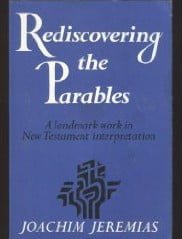
- Translation from Aramaic into Greek;
- Shifts from Jewish to Greco-Roman portrayals;
- Embellishments;
- Increased influence from the Old Testament and story lines or themes current in the first century;
- Shifts in audience between accounts;
- Conformation of the parables to the church’s task of exhortation;
- Increased influence of the early church;
- Increased tendency to employ allegory;
- Collection and fusion of multiple parables into fewer, composite accounts; and
- Shifts in literary setting.
After outlining his methodology, Jeremias addresses many parables individually, while grouping them into general, topical categories concerning: the day of salvation, God’s mercy for sinners, great assurance, crisis and warning, God’s immediately impending judgment, challenge to action, realized discipleship, the suffering and exaltation of Jesus, and the consummation (89–178). In his treatment of these parables, Jeremias attempts to follow Adolf Jülicher’s lead by interpreting the parables as having a single, major point and by avoiding the allegorizing tendencies of many parable interpreters before Jülicher’s time (71; cf. Blomberg 34, 42). In conclusion, Jeremias briefly draws his readers back to Jesus as the original source of the parables and reminders them that the parables, however mysterious they may be in some of their details, reveal something about the one who initially uttered them. This revelation, Jeremias argues, also necessitates some form of decision about actions and life in relation to Jesus on the part of those who hear or read the parables (181).
In this post:
  |
Leave a Reply